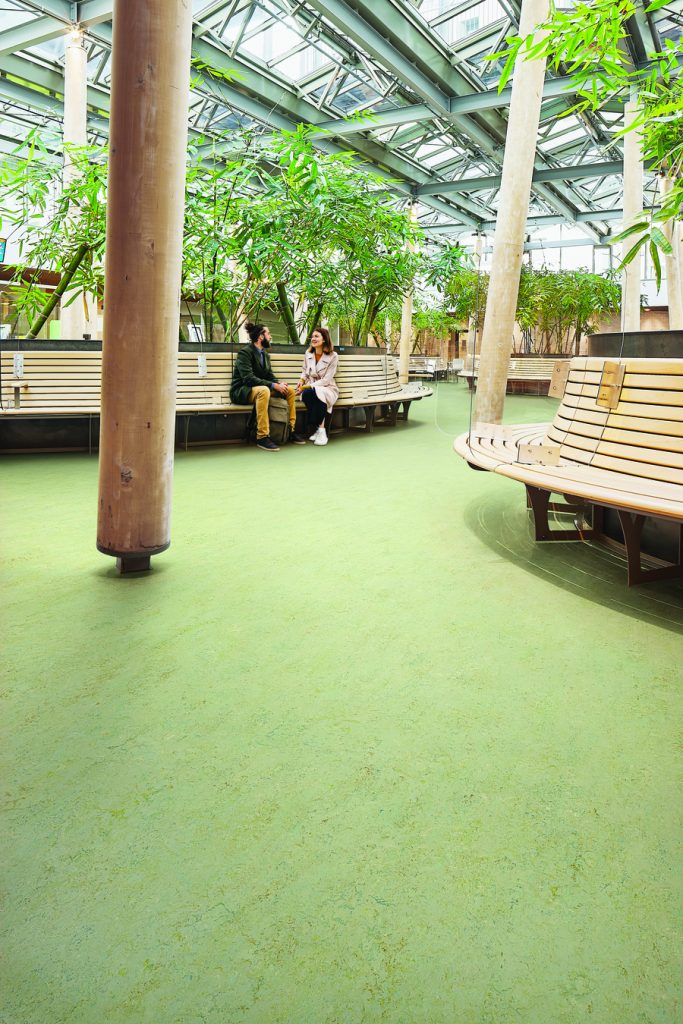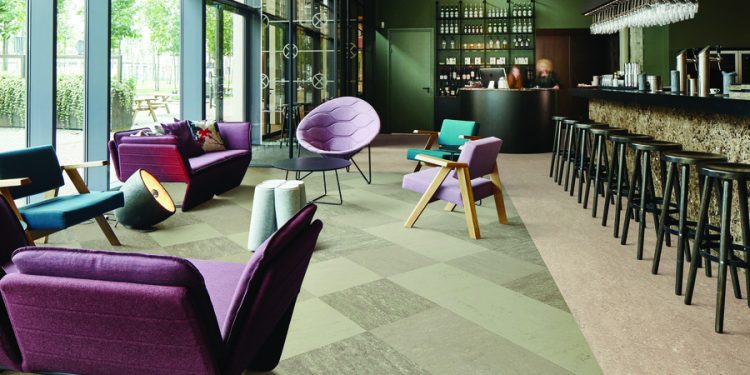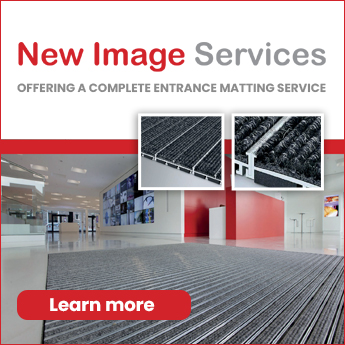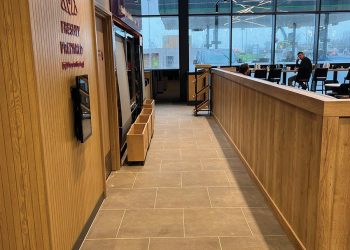MARMOLEUM is Forbo Flooring Systems’ own linoleum brand and is renowned for its durability, sustainability, high quality and innovative design. Here, I will explore linoleum, looking at how it’s manufactured, the benefits it can provide to those using the spaces it’s installed within – and much more.
Marmoleum is arguably the most sustainable floor covering available on the market right now. Made from 97% natural raw materials, it is CO2 neutral without the need for offsetting (cradle to gate). Combine this with the fact that it is truly versatile and available in over 300 designs in both sheet, tile and plank formats, it is a solution that ticks a lot of boxes when it comes to choosing floor coverings.
Who invented linoleum and what are its raw materials?
Linoleum’s origin dates back to the 19th century, where it was developed by Frederick Walton and originally manufactured by hand. While technological innovations have been introduced since then, only a handful of people can master the art of making Forbo’s Marmoleum. In fact, Forbo prides itself on having experts who can determine the right mixture of ingredients, maintaining the right time for the raw materials to settle and applying the correct temperature and pressure to create this innovative flooring solution.
Part of Marmoleum’s appeal is the materials used to make it; Marmoleum contains 97% natural raw materials, including pine rosin, linseed oil, wood flour, limestone, organic pigments and a jute mesh backing. In addition, Marmoleum is made from 61% renewable sources and contains 43% recycled and reused materials, all of which have led to Marmoleum winning an array of environmental certificates, such as the Nordic Swan and Blue Angel.

How is Marmoleum made?
Firstly, linseed oil and pine rosin are added to large boilers and mixed together to create linoleum cement; the linseed oil absorbs oxygen, and the rosin creates a flexible binder, called linoleum cement. This linoleum cement is then stored in containers for 10 to 14 days in a heated storage room, until it reaches the right consistency and elasticity. Wood flour is then added to create a firm, dry mixture.
Following this, finely ground limestone is added along with colour pigments to create a firm homogeneous mass in preparation for the final mixing stage. This mixture is shredded in various stages as it is being transported to storage lofts in preparation.
These granules form beds of different colour linoleum granules, with each bed producing approximately 15 rolls of linoleum. The linoleum granules are then transported to the final mixing process where they are calendared into a one-metre-wide sheet, which is then cut into two-metre-wide slabs using a special knife.
These slabs are then flipped over ready to be combined with the jute material – the backing for the finished flooring. The jute and the linoleum slabs then meet in front of a large calendar, with two cylinders of different temperatures and speed pressing the two layers together to the correct thickness. The sheet is then transported to a drying chamber, which is right behind the calendar, and it remains there for 14 to 20 days before receiving its top layer finish. A specially developed finish is applied in two layers, a primer and a finishing layer, both of which are UV cured, providing the sheet with lifelong protection. After this, every linear metre is inspected thoroughly, before being packaged and distributed to customers across the globe.
How does Marmoleum perform, once installed?
Alongside its environmental benefits, Marmoleum has many other positives to offer, such as its durability. Developed specially for Marmoleum, Topshield pro is Forbo’s high performance UV-finish which is applied to all of its Marmoleum offerings. Topshield pro has been shown to provide three times better protection than its predecessor. What’s more, with a new application process, the finish is tougher than ever before making the surface less susceptible to dirt build-up. It also requires no initial polymer application, making for a “ready to use floor”, which is better for the environment. Topshield pro also stops staining, scuffing and scratching for long-lasting appearance retention and makes it easy to clean and maintain. This means less material wastage when replacing damaged flooring and lower maintenance costs, bringing with it a much lower cost of ownership.
With the UK Government having set an aim to be at Net Zero by 2050 and construction accounting for 40% of carbon emissions yearly, finding options that can reduce the environmental impact of construction is paramount. What’s more, a recent study suggested that most new buildings could take decades to pay back their carbon debt – decades which need to be used to reduce their carbon output. As such, in response to this, many contractors are now turning to materials that can reduce the impact their projects have on the environment, such as Marmoleum. This is because Marmoleum is CO2 neutral from cradle to gate without offsetting. What this means is the CO2 produced in the extraction, transportation and manufacturing process of Marmoleum is balanced out by the removal of CO2 in the growing of the natural ingredients used to make it.
Marmoleum is good for the environment, but is it good for people too?
Thanks to the natural raw materials used to make it, Marmoleum is naturally bacteriostatic and has been independently proven to inhibit the growth and spread of infections like MRSA, Norovirus and more. Not only this, Marmoleum has been awarded the prestigious Allergy UK Seal of Approval, meaning it positively impacts the lives of those suffering with allergies. It also boasts 30 times lower TVOCs (Total Volatile Organic Compounds) than the European norm and is independently proven to contribute to a healthier indoor environment.
Marmoleum also contains no phthalates, plasticisers or mineral oils which are shown to have negative impacts on a user’s health. The absence of these potentially toxic materials is yet another benefit to those using the flooring and can help reduce unnecessary contact with harmful substances.
When it comes to reducing noise pollution, Marmoleum ticks the box, with some ranges providing a sound reduction of 18 dB. An obvious positive for education facilities, offices or healthcare settings where reducing sound can make for a more welcoming and peaceful environment.
What designs is Marmoleum available in?
Marmoleum is available in over 300 colourways and 12 different structures, and in sheet, tile and plank formats. With the sheet format allowing for intricate designs to be cut, whilst the plank and tile formats reflect the ever-growing trend of modularity. The modular offer provides a distinctive format that allows contractors to easily combine and connect various shapes, sizes and colours of tiles to create a completely unique flooring design.
The latest addition to Forbo’s Marmoleum collection is Marmoleum Linear, which features a softly striated design, reminiscent of wood, helping contractors to bring a touch of nature inside. This is in-keeping with the latest trends as many buildings start to move away from the more traditional look and into a more ‘human centric’ design. This range can also be combined with other Marmoleum offerings to create sustainable integrated flooring schemes and all designs are available in the Decibel construction, which delivers 18 dB impact sound reduction.
Forbo’s Marmoleum solutions range from this more modernised look to the more traditional and simplistic Marmoleum Solid, which features a more natural aesthetic, or Marmoleum Marbled which uses simple colours with a marbled pattern to create contemporary spaces.
From Marmoleum Linear to Marmoleum Marbled, there are designs to suit all tastes.
Where can you install Marmoleum?
With such a wide range of colourways and benefits, Marmoleum can be used in almost any environment. With antibacterial properties, durability, ease of cleaning and being as sustainable as they come, Marmoleum is a truly versatile offering.
These benefits make it perfect for almost any environment, such as high traffic areas like those found in education or retail buildings, where something that’s easy to maintain and durable is required. Alternatively, with antibacterial properties, Marmoleum is the perfect choice for healthcare facilities where a solution that can minimise the spread of infections is vital. Combine all these benefits with a range of contemporary designs and you can see exactly why it’s such a popular option.
- https://www.bbc.co.uk/news/business-53642581
Forbo Flooring SYSTEMS
01773 744 121
info.flooring.uk@forbo.com
www.forbo-flooring.co.uk
www.forbo-flooring.co.uk/marmolem












